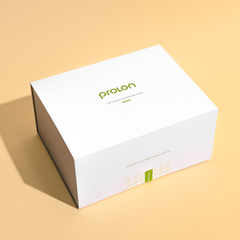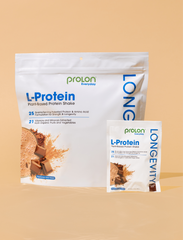
Just What Is Autophagy? 7 Things to Know About This Biological Superpower
Key takeaways:
-
Autophagy is the body’s natural mechanism for repairing and recycling old and damaged cells.
-
Autophagy empowers the body’s other biological processes to function more efficiently, thereby reducing the risk for age-related disease.
-
The most effective proven way to increase autophagy activation is through prolonged fasting.
-
The Prolon 5-Day Fasting Mimicking Diet (FDM) is the only program clinically shown to trigger autophagy while still allowing nourishment.
Did you know that Prolon’s 5-Day Fasting Mimicking Diet (FMD) triggers a biological “superpower” called autophagy that helps promote a more healthy and vibrant life? If you’ve never heard of autophagy before, or if you have but aren’t quite sure what it is or why it’s so impactful for your body’s health, let’s take a closer look. Here are seven key things to know about autophagy, and how this incredibly nuanced and natural process drives the benefits that make Prolon’s FMD so transformative.
1. Autophagy is your body’s cellular recycling program
The word “autophagy” combines the Greek words for “self” (auto) and “eating” (phagy). Autophagy is your body’s natural recycling system, clearing out old or damaged cells, and replacing dysfunctional components to support healthier, more productive ones. Think of it as a cellular reset that helps keep your system running at its best. As a result, these younger cells have been shown to help boost your body’s overall functionality, support key metabolic markers, and support a healthy immune system, all of which may slow the overall aging process and help prevent chronic disease.
2. Autophagy is an ancient survival mechanism
Autophagy is an evolutionary survival mechanism that helps the body adapt to food scarcity, stress, and injury by conserving resources and enhancing resilience. Since our ancestors commonly experienced extended periods of little to no food, autophagy acts as a means of maximizing cellular function and energy stores until food becomes available again. (e.g. if there isn’t any food, your body optimizes itself so that when food does become available after many days without, you still have the energy to hunt!) It’s also a genetically-regulated pathway that helps target and destroy harmful pathogens like viruses and bacteria that may invade cells; as a result, autophagy’s role in human survival through history has been both vital and multifunctional.
3. Autophagy research won a Nobel Prize
In 2016, Japanese cellular biologist Dr. Yoshinori Ohsumi was awarded the Nobel Prize in Physiology or Medicine for his discoveries about the mechanisms of autophagy. By studying the autophagic process of baker’s yeast, Ohsumi was able to identify the autophagy-related (ATG) genes, and link them to similar ATG in humans as well. His findings not only illuminated the importance of autophagy in several key biological processes, but also showed how dysfunctions or mutations of autophagy genes can lead to disease.
4. Autophagy is NOT cellular rejuvenation**
Though closely related, autophagy and cellular rejuvenation are not the same thing. Autophagy is the process your body uses to break down and recycle damaged cellular components, essentially cleaning out what no longer serves you. Cellular rejuvenation, on the other hand, is the resulting renewal that occurs once those old parts are cleared and replaced with new, high-functioning ones. You might think of it like renovating a home: autophagy is the demolition and cleanup, removing worn-out materials so they can be reused or replaced, while cellular rejuvenation is the beautifully restored space that emerges once the rebuilding is complete. On Prolon, you will experience both.
5. Autophagy is scientifically shown to extend lifespan
As we age, the buildup of cell damage grows more taxing for the body to manage on its own, and autophagy becomes less efficient. This makes stimulating the process—through regular fasting, for example—especially valuable for healthy aging. Autophagy’s cleanup and recycling of damaged cells supports longevity by promoting healthier metabolism, improving glucose control and fat storage, and reducing chronic inflammation—benefits that help protect the body from age-related diseases. In contrast, when autophagy is dysregulated, due to chronic disease, genetic mutation, age, or environmental pollutants, for example, it has been linked to inflammation-related conditions, including neurodegenerative disorders, cancer, and autoimmune diseases.
6. You can manually increase your level of autophagy
Autophagy is a natural biological process that increases when your cells experience certain stressors that deprive them of nutrients or oxygen. This means you can increase your autophagy rate by practicing things like calorie restriction, fasting, and/or high-intensity exercise:
-
Traditional calorie restricted (CR) diets—where daily caloric intake is reduced by 20–40%—have been shown to increase autophagy. However, studies suggest that to achieve meaningful, sustained autophagy-related benefits, CR must be maintained for extended periods—often 15 days to several months—which can be difficult to adhere to. In contrast, the Fasting Mimicking Diet (FMD) leverages patented nutrition technology to trigger many of the same cellular benefits of long-term calorie restriction—such as enhanced autophagy and cellular rejuvenation—within just five days, without prolonged deprivation.
-
High-intensity exercise like HIIT (high-intensity interval training) or sprinting, which create short bursts of energy using less oxygen, cause a kind of localized hypoxia that depletes your stores of glycogen. This forces the body to switch to other fuel sources like fat, and eventually ketones, very quickly. In these cases, autophagy has been shown to ramp up in response to the metabolic stress, but tends to be most active in the muscle tissue. Exercise-induced autophagy also tends to last for shorter bursts of time, as opposed to the more sustained autophagy that can be achieved from fasting.
-
Prolonged fasting is the most effective way to trigger whole-body autophagy, so cells can focus on deep, sustained repair and cleanup instead. Depending on your metabolism, it usually takes 72 hours of nutrient scarcity before the body activates autophagy in response to the perceived stress.
7. With Prolon, autophagy can be triggered even while you eat
Traditional prolonged fasting methods, like water fasting, can be difficult to sustain and often come with uncomfortable or even dangerous side effects. Prolon’s 5-Day Fasting Mimicking Diet (FMD) was created to offer a safer, more approachable alternative. By providing foods developed with patented nutrition technology that use precisely balanced macronutrient ratios to stay below the body’s nutrient-sensing pathways, the FMD keeps the body in a fasting state while still delivering nourishment. Backed by more than 25 years of research, the FMD is the only nutrition program supported by data confirming autophagy activation in humans, with clinical trials showing that three monthly cycles can reduce biological age by an average of 2.5 years while supporting both fat loss, muscle protection, and overall metabolic health.
The more we understand autophagy, the better we can help activate and support this incredibly nuanced and powerful biological mechanism for our entire lifetime. In doing so, we enhance the quality and healthspan of our longevity by empowering the body’s natural processes to do what they should do best: renew, repair, and rejuvenate for years to come.
Sources:
Cleveland Clinic. “Autophagy.” Website.
National Library of Medicine. National Center For Biotechnology Information. “Autophagy and inflammation.” Website.
National Library of Medicine. National Center For Biotechnology Information. “The Effects of Calorie Restriction on Autophagy: Role on Aging Intervention.” Website.
Nature Communications. “Fasting-mimicking diet causes hepatic and blood markers changes indicating reduced biological age and disease risk.” Website.
Science Direct. “Autophagy: A Critical Regulator of Cellular Metabolism and Homeostasis.” Website.
Science Direct. “Exercise-driven cellular autophagy: A bridge to systematic wellness. Website.Science Direct. “Neurodegenerative Disorder: Aetiology and pathophysiology of neurodegenerative disorders.” Website.
Science Direct. “Rest, Repair, Repeat: The Complex Relationship of Autophagy and Sleep.” Website.













